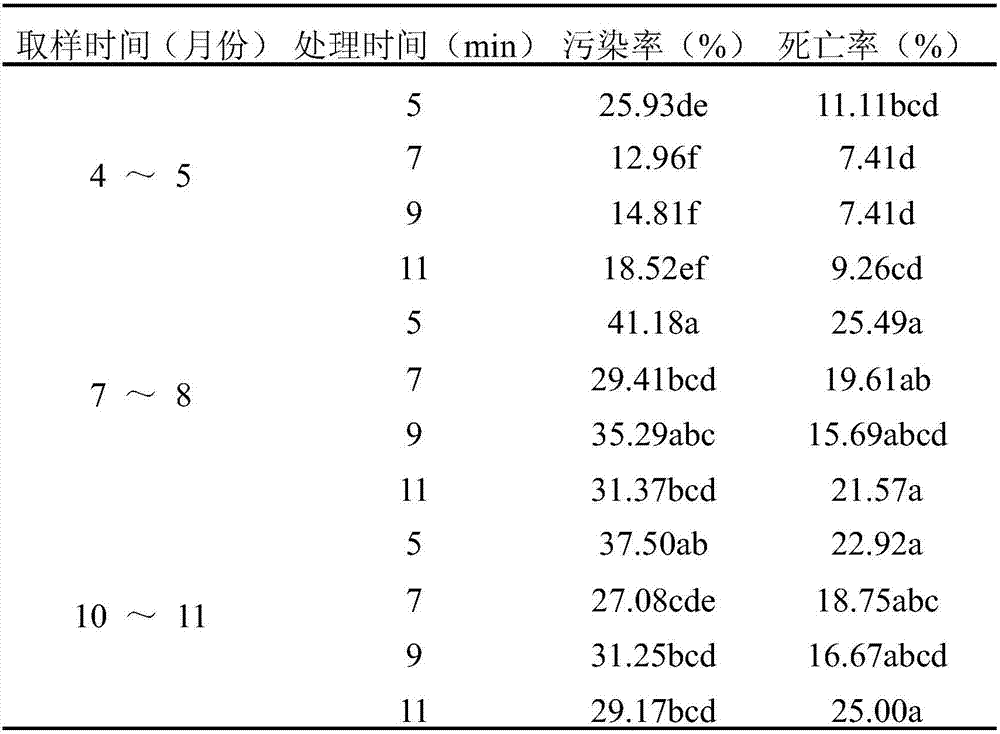Anti-browning and tissue culture proliferation method for dendrobenthamia tonkinensis
A four-photographing flower and anti-browning agent technology, applied in the field of plant tissue culture, can solve the problems of long seedling cultivation cycle, low production efficiency, low reproduction coefficient, etc., and achieve the effect of fast growth, normal color and good growth
- Summary
- Abstract
- Description
- Claims
- Application Information
AI Technical Summary
Problems solved by technology
Method used
Image
Examples
Embodiment 1
[0029] Embodiment 1, pollution anti-browning comparison
[0030] Selection of explants: In mid-April, May, July, August, October, and November 2014, healthy and disease-free vegetative branches of the current year were collected in Tokyo Sizhao Flower Nursery, Baima Base, Nanjing Forestry University. Cut out the stem segment with buds about 3-4 cm long at the node, keep 1 axillary bud, put it in the ice box and bring it back to the laboratory for later use.
[0031] Sterilization of explants: trim the leaves on the stems, keep the petioles and 1 / 5 of the leaves, rinse with tap water for 1 to 2 hours, then disinfect the cleaned stems on the ultra-clean workbench, first use 70 Soak in % alcohol for 30s, rinse with sterile water for 2 to 3 times, then soak in 0.1% mercuric chloride for 5, 7, 9, and 11 minutes, rinse with sterile water for 4 to 5 times, and set aside (see Table 1 below).
[0032] Establishment of a sterile anti-browning system: put the sterilized flower stems of To...
Embodiment 2
[0044] Embodiment 2, aseptic system germination rate comparison
[0045] Selection of explants: In mid-April 2015, healthy and disease-free vegetative branches of the current year were collected in Tokyo Sizhao Flower Nursery, Baima Base, Nanjing Forestry University, and 3-4 cm long strips were cut from the top 1 and 2 nodes. For the bud stem segment, keep 1 axillary bud, put it in the ice box and bring it back to the laboratory for future use.
[0046] Sterilization of explants: trim the leaves on the stems, keep the petioles and 1 / 5 of the leaves, rinse with tap water for 1 to 2 hours, then disinfect the cleaned stems on the ultra-clean workbench, first use 70 Soak in % alcohol for 30 seconds, rinse with sterile water for 2 to 3 times, then soak in 0.1% mercury chloride for 7 minutes, rinse with sterile water for 4 to 5 times, and set aside.
[0047] Establishment of a sterile anti-browning system: put the sterilized flower stems of Tokyo Sizhao on a sterilized filter paper...
Embodiment 3
[0051] Embodiment 3, proliferation culture formula comparison
[0052] Selection of explants: In mid-April, May, July, August, October, and November 2014, healthy and disease-free vegetative branches of the current year were collected in Tokyo Sizhao Flower Nursery, Baima Base, Nanjing Forestry University. Cut out the stem segment with buds about 3-4 cm long at the node, keep 1 axillary bud, put it in the ice box and bring it back to the laboratory for later use.
[0053] Sterilization of explants: trim the leaves on the stems, keep the petioles and 1 / 5 of the leaves, rinse with tap water for 1 to 2 hours, then disinfect the cleaned stems on the ultra-clean workbench, first use 70 Soak in % alcohol for 30s, rinse with sterile water for 2 to 3 times, then soak in 0.1% mercuric chloride for 5, 7, 9, and 11 minutes, rinse with sterile water for 4 to 5 times, and set aside.
[0054] Establishment of a sterile anti-browning system: put the sterilized flower stems of Tokyo Sizhao o...
PUM
 Login to View More
Login to View More Abstract
Description
Claims
Application Information
 Login to View More
Login to View More - R&D Engineer
- R&D Manager
- IP Professional
- Industry Leading Data Capabilities
- Powerful AI technology
- Patent DNA Extraction
Browse by: Latest US Patents, China's latest patents, Technical Efficacy Thesaurus, Application Domain, Technology Topic, Popular Technical Reports.
© 2024 PatSnap. All rights reserved.Legal|Privacy policy|Modern Slavery Act Transparency Statement|Sitemap|About US| Contact US: help@patsnap.com










